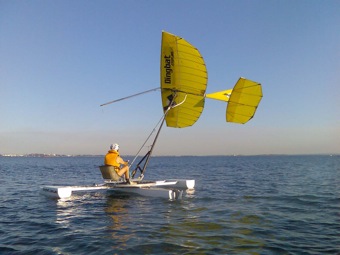

Trial 10, 10 March 08
Breeze <5 knots, but ok to test the new gear which gave much better control and easier set-up. Tacking was difficult and gibing slow due to lack of boat speed and wing yaw control.
Trial 11, 8 May 08
The breeze was good for training at about 10 knots. Took off from the beach in a rush, tacked badly, caught the elevator on the boom which pushed it down, stripping an already weakened thread on the support strut. The wing dropped into Botany Bay, we packed up and went home. Very disappointed.
The boom is normally strong enough to sink one outrigger without difficulty. Last year I pulled the wing into the water, to attach the experimental power control line to the ‘fuselage’, by just hanging from the boom and going hand over hand out to the end. When finished, I went back the same way, the wing popped up, ready to go.
Trial 12, 15 May 08
Predicted 10/15 knots wind, actually <5 knots. Puddled around, but did a test wing drop and raise in the bay without assistance. We must be able sail the commercial Dingbat single-handed, so this was reassuring and water drained from the double surface part of the sail in under thirty seconds.
Bill’s Blog @ May 2008
Other work commitments have interrupted development, but much thought was put into improving ease of use and wing handling in light and variable winds.
After successfully testing a direct wing power control line on the previous test, the concept was formalised as a lever operated linkage which allowed tacking without a line getting wrapped around the boom. This was a proof of concept only as a more elegant equivalent has been devised for the production boat.
The control works somewhat like the mainsheet on a conventional sailing boat except that the pivot point has been moved back from the leading edge towards the centre of lift, to minimise the force required to pull to maximum power. A sailboard works in the same way, with the sailor hanging their weight on a line attached near the centre of lift while using there arms to generate the much smaller force required to control angle of attack.
A boom winch was finally added, so the sailor to raise and lower the boom from the seat, allowing the boat to be set up without any help. This works on land or water.
Controls were added to allow the outriggers to be deployed and stowed from the driver’s seat. Deployed, the fully rigged boat to be moored safely (temporarily!). Stowing them moves the centre of mass aft to prevent nose diving at speed and also eliminates the possibility of hitting a wave with one outrigger and spinning the boat. The wing roll lever is used to keep the boat level in sailing mode, or the wing can be locked horizontal to act as a hands-off skyhook for short-term parking.
Next steps
The tailplane was originally included to simplify control while sorting the boat out, but although it has helped when under way, it occasionally gets caught on the boom in light, variable winds and prevents the wing weathervaning properly. The tailless wing has therefore become a priority and is now being designed.
When Dingbat development started ten years ago, a special wing was designed because no high efficiency wing of the right size was available off-the shelf; that has recently changed. The Neil Pryde RS series of sailboard sails now have a deep luff pocket which should give similar performance to our current 30% double surface rigid batten wing. These have been well tested by Pryde at high speed, are more crash-proof and cheaper than the current wing, they are also undergoing continuous development. A frame is being designed to attach a pair of RS Race 4.6m^2 sails to the current boat, and should be ready to test in a few months, other work permitting. The sails will be standard and complete with all hardware except for the boom, which will be replaced by part of the special frame. The current drop-on snap-fit attachment system will be maintained.
Volunteers?
One limitation to our testing programme is the lack of people to help during the week. There is no hard work, but we need one or two people, a power boat license, (we supply a basic 25hp ‘chase’ boat, but you’re welcome to bring your own), and the ability to follow Dingbat around Botany Bay and tow it to shore if it breaks something or the wind dies. Photographic skills an advantage, video and still cameras provided. Lunch is also provided. See the Volunteers tab for details.



